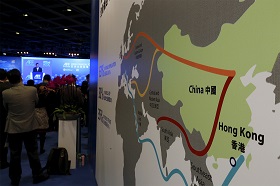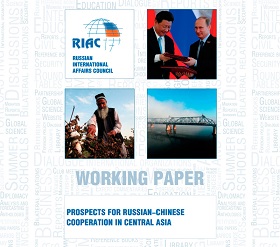Economic and political growth of China in the last two decades has become the key factor in global policy, and though the Chinese economy has somewhat cooled down lately, Beijing’s economy still continues to rise. In this context the factor of China’s empowerment is explicitly important for the neighboring Central Asia region.
PRC and Kazakhstan signed 22 commercial agreements worth USD 7 billion during the SCO Summit that was held in Astana on June 8-9, 2017. According to the agreements, the Chinese side is investing in the development of Kazakhstan’s agrochemical cluster and is implementing a number of projects in the Atyrau region, a free economic zone. Moreover, the Hydrochina Corporation of China signed a memorandum with the Kazakh SAMRUK-ENERGO Holding Company on construction of a wind power plant in the Almaty region and a network of minor hydro-electric power stations.
Previously, in the beginning of May, Beijing signed a whole package of economic agreements with Uzbekistan for the sum of USD 20 billion which implies enhanced cooperation between the two countries in the chemical utilization of natural gas and hydropower engineering, including the construction of a plant to generate synthetic liquefied fuel and a middle-term contract on the shipment of natural gas to PRC.
Economic and political growth of China in the last two decades has become the key factor in global policy, and though the Chinese economy has somewhat cooled down lately, Beijing’s economy still continues to rise. In this context the factor of China’s empowerment is explicitly important for the neighboring Central Asia region.
PRC and Kazakhstan signed 22 commercial agreements worth USD 7 billion during the SCO Summit that was held in Astana on June 8-9, 2017. According to the agreements, the Chinese side is investing in the development of Kazakhstan’s agrochemical cluster and is implementing a number of projects in the Atyrau region, a free economic zone. Moreover, the Hydrochina Corporation of China signed a memorandum with the Kazakh SAMRUK-ENERGO Holding Company on construction of a wind power plant in the Almaty region and a network of minor hydro-electric power stations.
Previously, in the beginning of May, Beijing signed a whole package of economic agreements with Uzbekistan for the sum of USD 20 billion which implies enhanced cooperation between the two countries in the chemical utilization of natural gas and hydropower engineering, including the construction of a plant to generate synthetic liquefied fuel and a middle-term contract on the shipment of natural gas to PRC.
Strategically Important Region
The independence of the Central Asian in 1991 marked a dramatic change for China in its geopolitical surroundings. The Chinese government understood that the Central Asia region would act like a “strategic rear” for PRC, while its foreign policy “front” would be turned towards the sea.
In recent years, the Central Asian states have fully felt the change in China’s economic strategy which resulted in the boost of foreign investments. The PRC government wagered on investment activity and the use of productive capacities abroad. Beijing’s new strategic image is represented by the “One Belt, One Road” initiative that directly affected the countries of Central Asia with infrastructure projects and multi-billion dollar contracts. Economic cooperation between China and the countries of Central Asia has been actively developing on bilateral basis in the recent years without being dependent on the SREB initiative.
A new factor in Beijing’s policy towards Central Asia was adding the necessity for the country’s western regions development to PRC’s domestic agenda due to existing major disproportions in the country’s regional dynamics. China’s western regions have more connections with Central Asia. Almost one third of Chinese Xinjiang Uyghur autonomous region trade goes to Kazakhstan, with the development of the Western Central Asia regions being well covered in Beijing’s program documents.
Cooperation with the countries of Central Asia in countering extremism and supporting regional stability has become quite pending with China in recent years. Beijing is very concerned about the birth of Islamist movements in Kazakhstan and Kyrgyzstan and the spread of radical ideas. In August 2016, a suicide bomber in a car attacked the Embassy of PRC in Bishkek. No Chinese diplomats were injured though the anxiety still remained. The Chinese government does not want the creation of Islamist movements in Chinese territory, especially in the Xinjiang Uyghur autonomous region, where Beijing has been fighting underground terrorist cells for many years. Nowadays, China and Central Asian states are solving the issues of countering terrorism and supporting regional stability in both bilateral format and in terms of SCO cooperation.
Key Features and Mechanisms for Cooperation
In the last several years China has become a major importer for three countries of Central Asia out of five: Kyrgyzstan, Tajikistan, and Uzbekistan. In 2015, 56% of all imports in Kyrgyzstan came from China. The situation in Tajikistan is a little different, with imports from China making 41%. China is also the leader in imports to Uzbekistan at about 20%. It is only in Kazakhstan and Turkmenistan that China is giving way to other countries, especially Russia and Turkey. The goods exported from China to the countries of Central Asia are representing a wide range of things including cars, equipment, food, basic goods, etc.
In terms of export, China has become a shipment destination for goods from Turkmenistan and Kazakhstan with the share of China’s exports in Turkmenistan’s having a record high of 68%. At the same time, the export from Ashkhabad to China is mainly composed of carbohydrates. As for Kazakhstan, its share in export to China is 15%. It also mainly consists of oil and gas, but in general Kazakhstan’s exports are more diversified than those of Turkmenistan. China is the second largest exporter to Uzbekistan. Tajikistan and Kyrgyzstan, who don’t possess sufficient reserves of the goods popular in PRC can hardly export anything to Beijing: the export of their own goods to China does not play any definite role for them and the balance of the external trade with PRC is highly negative.
The key role in supporting China’s economic penetration in Central Asia is played by the so-called tied loans. They provide finance for projects at relatively low interest rates, though the condition for such subsidies is the use of Chinese raw materials, equipment, or workers in performing the work. The transfer of shares and application of the agreements on production sharing are typical. The application of these practices allows to employ Chinese productive capacities to a maximum extent, and the transfer of shares leads to a gradual increase of China’s economic presence in different economic areas in the countries of Central Asia.
The peculiarity of economic cooperation between Central Asia and China in the recent years is the correlation of the domestic economic development programs of these countries with Beijing’s strategy. This is being done in order to use the opportunities for Chinese financial resources at full scale. Kazakhstan has been implementing Nurly Zhol, a state program based on infrastructure development, since 2015. It involves large scale investment in the construction sector and the renewal of transport infrastructure of the country. The implementation of Nurly Zhol is closely tied to Chinese initiatives on constructing “The Silk Road Economic Belt,” a transport-logistical infrastructure, in Central Asia partially with Chinese investment. On June 8-9 at SCO Summit in Astana the President of Kazakhstan, Nursultan Nazarbayev, and the Leader of PRC, Xi Jinping, discussed the course of coordination between Nurly Zhol and SREB. The government of Tajikistan also wants to coordinate the implementation steps of the National Strategy for the Development of the Republic until 2030 with Beijing. The PRC State Bank delegation visited Dushanbe this month to study the issues of cooperation in a number of areas such as telecommunications, mining, agriculture, and hydropower industry.
Chinese Presence and Eurasian Integration
Russia and China are currently the countries with the strongest political and economic presence in some regions in Central Asia.
Strengthening PRC’s positions in Central Asian region directly touches upon perspectives of Eurasian integration, as integration initiatives promoted by Moscow and Beijing, such as EAEU и SREB, are addressed towards economic and political structuring of the neighboring regional space around its own nucleus. There are at least two approaches to estimate cooperation of the Eurasian integration project with Chinese economic initiatives in the region. On the one hand, Central Asia is becoming a territory where different integration projects manage to co-exist and complement each other. The bias of these Central Asian states that are no longer objects of colonization is growing as well: today these countries are actively shaping their own agendas and to this extent they tend to have multi-vector policies. On the other hand, there is competition between Moscow’s and Beijing’s integration projects, creating a zero sum game. The launch of EAEU is partially an attempt to limit the expansion of goods from China and to create an opportunity for post-Soviet countries to restart their own industrialization programs. That is why the Eurasian integration union is not being favorably disposed towards the idea of a full-scale free trade zone between EAEU and China, something that is widely supported in Beijing. There is another issue, as Moscow is in favor of a unified position of EAEU countries in terms of cooperation with China and is therefore encouraging them to act like a “single front.” Beijing is subverting this “single front,” aiming for bilateral cooperation with the countries of Central Asia.
The strong point of China’s economic policy in Central Asia is not only the flexibility of bilateral cooperation and a sufficient financial resource but also Beijing being able to provide a wide range of areas for cooperation. Nevertheless, there are factors that limit the growth of economic and political influence of China in Central Asia. Regardless of the advantages of cooperation with Beijing, Central Asian countries are not interested in being economically and politically dependent on China. The limiting factor is the objective necessity in developing their own productive economy. The countries of the region are likely to try and balance Beijing’s growing influence by different forms of political, economic, and military cooperation with other power centers. One of the most favorable scenarios for the countries of Central Asia would be a situation where several key players have a position of constructive cooperation while balancing each other at the same time.







